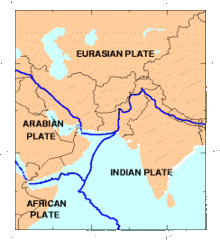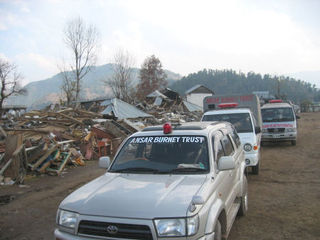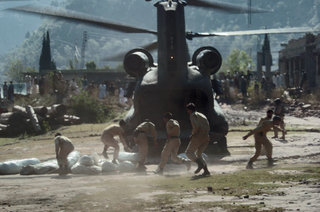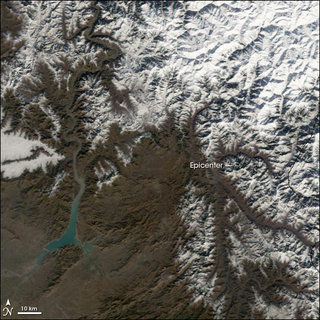2005 Pakistan earthquake
2007 Schools Wikipedia Selection. Related subjects: Natural Disasters
| 2005 Kashmir earthquake | ||
|---|---|---|
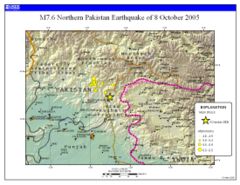 |
||
| Date | October 8, 2005 | |
| Magnitude | 7.6 Mw | |
| Countries affected | Pakistan, India, Afghanistan | |
| Casualties | 74,500+ dead 106,000+ injured |
|
The Kashmir earthquake (also known as the South Asia earthquake or Pakistan earthquake)lots of people died and i had a few friends whose family and friends died in it of 2005 was a major earthquake whose epicenter was the Pakistan-administered disputed region of Kashmir. The earthquake occurred at 08:50:38 Pakistan Standard Time (03:50:38 UTC) on October 8, 2005. It registered a minimum magnitude of 7.6 on the moment magnitude scale making it a major earthquake similar in intensity to the 1935 Quetta earthquake, the 2001 Gujarat Earthquake, and the 1906 San Francisco earthquake. As of 8 November, the Pakistani government's official death toll was 73,276, while officials say nearly 1,400 people died in Indian-administered Kashmir and four people in Afghanistan.
Human impact
Most of the affected people lived in mountainous regions with access impeded by landslides that blocked the roads, leaving an estimated 3.3 million homeless in Pakistan. The UN reported that more than 4 million people were directly affected, prior to the commencement of winter snowfall in the Himalayan region. It is estimated that damages incurred are well over US$ 5 billion (30 billion Pakistani rupees) Five crossing points were opened on the Line of Control (LoC) between India and Pakistan to facilitate the flow of humanitarian and medical aid to the affected region.
The earthquake
Kashmir lies in the area of collision of the Eurasian and Indian tectonic plates. . The geological activity born out of this collision, also responsible for the birth of the Himalayan mountain range, is the cause of unstable seismicity in the region. The United States Geological Survey (USGS) measured its magnitude as a minimum of 7.6 on the moment magnitude scale, with its epicenter at , about 19 km (11.8 miles) northeast of Muzaffarabad, Pakistan, and 100 km (65 miles) north-northeast of the national capital Islamabad. The earthquake is classified as "major" by the USGS. The hypocenter was located at a depth of 26 km (16.2 miles) below the surface . The Japan Meteorological Agency estimated its magnitude at a minimum of 7.8. By comparison, the 2004 Indian Ocean earthquake had a magnitude of 9.15. The earthquake caused widespread destruction in northern Pakistan, as well as damage in Afghanistan and northern India. The worst hit areas were Pakistan-administered Kashmir, Pakistan's North-West Frontier Province (NWFP), and western and southern parts of the Kashmir valley in the Indian-administered Kashmir. It also affected some parts of the Pakistani province of Punjab and the city of Karachi experienced a minor aftershock of magnitude 4.6. There have been many secondary earthquakes in the region, mainly to the northwest of the original epicenter. A total of 147 aftershocks were registered in the first day after the initial quake, of which one had a magnitude of 6.2 Twenty-eight of these aftershocks occurred with magnitudes greater. On October 19, a series of strong aftershocks, one with a magnitude of 5.8, occurred about 65 km (40.5 miles) north-northwest of Muzaffarabad. There have been more than 978 aftershocks with a magnitude of 4.0 and above, as of 27 October that continue to occur daily. (See USGS for a list of recent aftershocks and effects.)
Casualties
| 2005 Kashmir earthquake casualties | |||
| Location | Dead | Injured | |
| Pakistan ( NWFP & Kashmir) | 73,276 | 100,000 | |
| India (Kashmir) | 1,360 | 6,266 | |
| Afghanistan | 4 | ||
| Total | 74,500+ | 106,000+ | |
Most of the casualties resulting from the earthquake were in Pakistan where the official confirmed death toll is 73,276, putting it higher than the massive scale of destruction of the Quetta earthquake of May 31, 1935. Nearly 1,400 people died in Indian-administered Kashmir, according to officials. International donors have estimated that about 86,000 died but this has not been confirmed or endorsed by Pakistani authorities.
As Saturday is a normal school day in the region, most students were at schools when the earthquake struck. Many were buried under collapsed school buildings. Many people were also trapped in their homes and, because it was the month of Ramadan, most people were taking a nap after their pre-dawn meal and did not have time to escape during the earthquake. Reports indicate that entire towns and villages were completely wiped out in Northern Pakistan with other surrounding areas also suffering severe damage.
"...a second, massive wave of death will happen if we do not step up our efforts now", Kofi Annan said on 20 October with reference to the thousand remote villages in which people are in need of medical attention, food, clean water and shelter and the 120,000 survivors that have not yet been reached.
Prime Minister Shaukat Aziz "made the appeal to survivors" on 26 October to come down to valleys and cities for relief, because bad weather, mountainous terrain, landslides and blocked roads are making it difficult for relief workers to reach each house and the winter snows are imminent.
Damage
Pakistan
- An assessment of damaged buildings in Muzaffarabad and the surrounding area, by the Earthquake Engineering Centre of the University of Engineering and Technology, Peshawar, showed that about 60% of the buildings in urban areas were unreinforced solid concrete block masonry buildings and it was the collapse of more than 60% of these buildings that was responsible for the majority of deaths and injuries.
- Pakistani television reports widespread severe damage to Balakot (almost completely wiped out), Garhi Habibullah, Rawalakot, and Muzaffarabad (near the epicenter) where 30,000 are thought to have died. The Pakistani Army spokesman, Major General Shaukat Sultan, told a press conference on 10 October that reports of damage in Rawalakot were exaggerated; 90 percent of the garrison city is still standing.
- The quake triggered landslides, burying entire villages and roads in many areas of North-West Frontier Province and Pakistan-administered Kashmir.
- Hundreds of thousands of buildings are thought to have collapsed or sustained severe damage.
- One of two residential towers (Margalla Towers in F-10 sector, Islamabad), believed to contain up to sixty apartments each, collapsed in the earthquake in Islamabad. Pakistani government officials at the site stated the number of people affected by the collapse was in the hundreds, most of whom are feared dead. Efforts by rescue workers are ongoing. Over fifty-two people were rescued from the collapsed residential "Margalla Towers".
- A team from the International Rescue Corps at the site said they located three more victims on the Sunday morning using audio detection equipment after the difficult task of arranging total silence at the crowded rescue site.
- The Karakoram highway is blocked at several points, hindering relief efforts.
- Damage to buildings and several casualties have been reported in surrounding provinces of Punjab and Balochistan.
India
- 1,500 houses were destroyed in Uri. About 90% of the families living in the town, which has a population of 30,000, were affected by the quake. *More than 1,100 houses were flattened in Jammu and Kashmir. The main minaret of the Hazratbal shrine, which houses a relic of the Prophet Muhammad was damaged.
- The 200-year-old Moti Mahal fort in Poonch district, Kashmir, collapsed.
- Buildings in Delhi and Amritsar were damaged, and tremors caused panic in Gujarat.
- The tremors were also felt in Uttar Pradesh, Uttaranchal, Himachal Pradesh, Rajasthan, and Madhya Pradesh.
- There were over 1300 dead.
Afghanistan
Four deaths were reported in Afghanistan, including a young girl who died in Jalalabad after a wall collapsed on her. The quake was felt in Kabul, but the effects were minimal to a certain extent.
Rescue and relief operations
Relief efforts in many remote villages are hampered, as roads are buried in rubble and many affected areas remain inaccessible. Heavy equipment is needed to clear the roads and to rescue survivors buried under the earthquake wreckage, as many rescuers are still picking the rubble with pickaxes and their bare hands, looking for survivors.
Rescue effort are also affected by the numerous aftershocks that continue to rattle the region and put rescue workers in danger as they search through the wreckage for survivors. Five crossing points are to be opened on the Line of Control (LoC) between India and Pakistan in the province of Kashmir. The first has been opened at Chakan Da Bagh in Poonch, the second at Kaman Post in Uri (on the road between Srinagar and Muzaffarabad) and the third across the Neelum river between Chiliana in Pakistan and Tithwal in India. These will facilitate the flow of relief goods and allow people to meet relatives across the Line of Control.
In many areas there is no power, or adequate food or water; there is also the danger of disease spreading , including measles. Distributing relief supplies to the victims is especially urgent as the victims face the risk of exposure to cold weather due to the region's high altitude and the approaching winter. Food, medicine supplies, tents and blankets have been identified by relief workers as essential items. On October 10, the United Nations warned that the earthquake left 2.5 million people homeless and they are in need of shelter. The UN made an appeal to raise US$272 million to help victims.
On October 13, snow started to fall on the Indian side of Kashmir. Many regions are facing an increasing threat of being cut off from help as snow forces closures of even more roads in the mountainous region.
Pakistan
In Northern Pakistan and Pakistan-administered Kashmir, the Pakistan Army has been directed to ask the concerned authorities to carry out an immediate assessment of the extent of damage caused by it. The Government of Pakistan opened President's Relief Fund for Earthquake relief operation, where donations can be made and also appealed for International Aid as the magnitude of the disaster becomes clear. Earthquake relief blankets, tents, medicine, warm clothes, food and many more supplies are needed. Pakistan International Airlines (PIA) has offered free delivery of goods from anywhere in the world to Pakistan. Turkey has offered to airlift relief goods that arrive in Turkey to Pakistan free of cost. Pakistani Prime Minister Shaukat Aziz spoke on the telephone with authorities in four provinces plus Azad Kashmir, and directed them to utilize all machinery and make all possible efforts to help the victims. He said the entire federal administration, civil and military authorities have been alerted, and relief goods have been provided to them for the victims of the quake. Most of the roads are closed in the Northern Sector near the earthquake, and some have been completely washed out or blocked by landslides, so the Pakistani army is flying supplies in by helicopter. In Garhi Habibullah, a town 205 miles (328 km) from the devastated city of Balakot in north-west Pakistan, a few Kashmiri fighters known as the mujahideen put aside their weapons and spent two days in helping rescue dozens of girls who were trapped in a collapsed building of a girls' school. However, some terrorist groups operating in Kashmir continued to attack and kill Kashmiris in the Indian state of Jammu and Kashmir to prove that despite reports by India that claimed that terrorist training camps in Pakistan were destroyed, the militant network was still alive. On October 10, Monday, survivors were still being found and rescued from the wreckage including a 2-year-old girl in Islamabad. Then on Wednesday, a Russian rescue team rescued a 5-year-old girl in Muzaffarabad who has been trapped for nearly 100 hours. On October 14 the Pakistan government agreed that unaccompanied children from the disaster should be taken to the SOS Children emergency shelter in Islamabad for family tracing in a central database and help and created a credit programme for affected families. They also agreed that SOS should be temporary guardian until relatives were traced. The Pakistani people from all regions and walks of life donated a huge amount of relief supplies in both goods and money for the earthquake victims which is unprecedented in the history of nations. The magnitude of this disaster is so vast that the Government alone cannot provide relief to the people affected by this earthquake. The response of the people of Pakistan to help the government in its relief efforts has been overwhelming in the shape of donations, relief goods and volunteers working in the hospitals and the earthquake hit areas. The injured are being ferried from remote areas to the hospitals of Rawalpindi and Islamabad through helicopters every day. The relatives of these injured patients follow them to the twin-cities by road and pursue a long and painful search for their loved ones. Devastated with heavy losses of human lives and homes, these poor people often travel on foot from one hospital to another looking for their injured loved ones. Three surgeons from Harley Street went out for a week to help with the victims of the earthquake and set up a field hospital in the town of Bagh.
In late 2006, a staggering $20 billion development scheme was mooted by Pakistan for reconstruction and rehabilitation of the earth-quake hit zones in Azad Kashmir. A land use plan for Muzaffarabad city had been prepared by Japan International Cooperation Agency.
India
- In the Indian-administered Jammu and Kashmir, the injured are being treated at Srinagar's SMHS hospital and the Uri Field Hospital, with many makeshift medical facilities being set up to help the injured. Hundreds of people have been brought in, many of them critically injured. In keeping with a traditional duty since independence, the Indian Army has undertaken a key role in coordinating and running relief operations.
- Indian Prime Minister Manmohan Singh, and Leader of the Opposition L.K. Advani visited quake-hit areas An ex gratia of Rs one lakh (100,000 Indian rupees, about US$2255) to the next of kin of those killed in the quake was being released from the Prime Minister's National Relief Fund.
- As of 10 October 2005, many areas in the Baramulla district with about 15,000 people remain inaccessible. The army is attempting to reach these people using helicopters
International response
Many countries, international organizations and non-governmental organizations have offered relief aid to the region, in the form of donation as well as relief supplies including food, medical supplies, tents and blankets.
Rescue and relief workers were sent to the region from different parts of the world and they brought along rescue equipment, including helicopters and rescue dogs.
The United Nations has appealed for donations to raise at least US$272 million to help victims of the quake.
